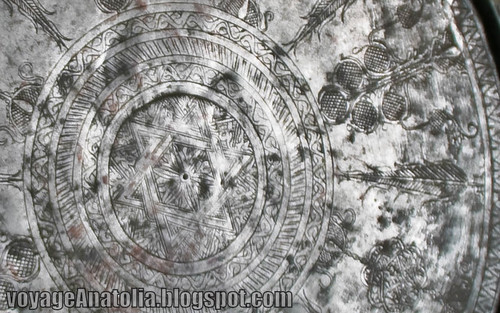
Solomon's Seal, originally uploaded by voyageAnatolia.blogspot.com.
In Medieval Jewish, Christian and Islamic legends, the Seal of Solomon was a magical signet ring said to have been possessed by King Solomon, which variously gave him the power to command demons, genies, or to speak with animals.

Old pewter copper tray with Seal of Solomon.
A well-known story in the One Thousand and One Nights describes a genie who had imprisoned in a copper bottle for 1,800 years by King Solomon and being locked with a lead seal and thrown into the sea. Since the bottle was sealed with Solomon's seal, the genie was helpless to free himself, until freed many centuries later by a fisherman who discovered the bottle.
In alchemy, the combination of the fire and water symbols (up and down triangles) is known as the Seal of Solomon. The symbol is representative of the combination of opposites and transmutation. By combining the alchemical symbols for fire (upwards triangle) and water (downwards triangle), the alchemical symbols for earth and air are also created. The downwards facing triangle is divided along the center by the base line of the opposite triangle. This is the alchemical symbol for earth. Conversely, the upwards triangle divided by the base line of the downwards triangle is the alchemical symbol for air. The Seal of Solomon is all that is unified in perfect balance; the Spirit Wheel, Merkabah. More...